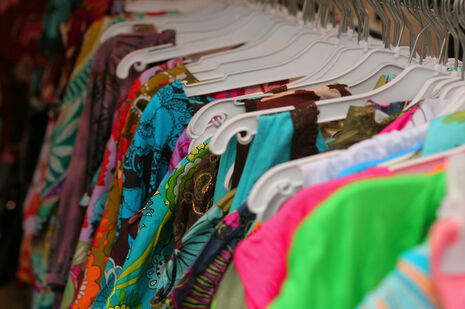Trans fashion
The fashion industry has recently witnessed a number of developments in the representation and discussion of trans issues. What is the experience, however, of fashion for trans people off the catwalk? Here are a number of insights into the everyday realities of trans fashion

‘Trans people – especially trans women – face a lot of stereotypes when it comes to clothing and presentation. How many films or TV shows have you seen with a trans woman character, and how many of those showed a shot of her putting on lipstick, a dress, a wig, tights, heels? Scenes like these tend to reinforce a deadly myth; that trans people’s genders are effectively costumes, and that without these costumes, we can’t possibly be (and, therefore, be seen and treated with respect as) the genders we really are.
“For a non-binary person – someone who is neither male nor female – you’d think that these binary stereotypes would be there to be broken. However, non-binary people tend to come across a whole new set of hurdles when it comes to fashion. Pre-existing expectations of what it means to be ‘androgynous’ tend to centre white, skinny, physically abled, AFAB (assigned-female-at-birth) bodies, to the detriment of all other expressions of androgyny. ‘Gender-neutral’ clothes adhere almost exclusively to a masculine default. In addition, there comes the assumption that non-binary people will even want to dress ‘androgynously’, and that if we don’t, we are failing at breaking down gender stereotypes – a job that none of us, in simply being who we are, ever signed up for in the first place.“Hopefully, the following handful of trans students’ experiences with fashion and gender will debunk some of the assumptions made about trans people, as well as representing some of the intersections – with class, and with sizeism, to name just two – that typical binary trans narratives often fail to take into account.” - Em Travis
“I feel like I ought to preface this by saying that there are poorer people than me in Britain. However, without name-dropping financial support systems or throwing around household incomes, I feel painfully working-class in Cambridge whilst also feeling deeply privileged at home. That said, the idea of replacing the contents of my wardrobe to better reflect my gender identity is intangible to me. I’ve never bought a new wardrobe – skirts and jumpers from my childhood still fall in and out of my personal fashion.
“If anything was to go, it’d have to be replaced. Within financial constraints, that leaves no room for transition – clothes become, rather than self-expression, a kind of personal inertia. When you can’t afford it, there is no ‘welcome to your real self’ make-over, or late-adolescent flurry of personal reinvention.
“Clothes are not inherently gendered to me. I enjoy putting on a tight dress, smiling to myself and saying – ‘look at that boy – isn’t he pretty’. But on a level that pre-dates my identification as trans, I wish I had a choice in the matter. I eke out the gender fluidity in my wardrobe in the same way I’ve been re-imagining the same clothes all my life.
“Sometimes I just crave the freedom to throw old things away.” - Anonymous
“After seven years at an all-girls’ school, the idea of being anything other than cis was alien to me. It’s only recently that I have come out as a gender-fluid person and there have been few wardrobe changes. Sure, I have clothes that are ‘gendered’ for men AND women, but who’s to say I can’t feel like a guy and wear a pair of heels if I want? Or be a girl in a suit?“The most important thing I ever purchased was a good binder from eBay... suddenly I didn’t have to have that sinking feeling of looking in the mirror and seeing a body that didn’t belong to me. My only reason for more clothes was for self expression; I picked up pieces as I found them, ranging from second-hand clothes that had been repaired to a new lease of life (from eBay or charity shops), sale items, supermarket clothes, but best of all, the ones I made that not only fit me well (nigh on impossible for anything other than baggy t-shirts in the men’s section) but reflected my inner quirkiness which had been hidden after so many years as a heteronormative person.” – Roisin Huskinson
“As someone who identifies as gender-fluid, I am often told by well-wishers that I ought to wear whatever I want and behave however makes me feel my most authentic self. It so happens that I prefer to wear masculine clothing, appreciating the fit of a suit jacket or argyle jumper, and have no desire to explore alternatives. Furthermore, I rather think that wearing high heels would be a nuisance on the smoothly-paved streets of New York, let alone the uniquely complex system of paving in Cambridge.” - Anonymous
“Before I transitioned I stomped around town wearing jeans, black band t-shirts and a leather trench coat. Nowadays I’m much happier and can regularly be seen stomping around town wearing jeans, black band t-shirts and a leather trench coat. What – you thought there would be some amazing transformation and I would be suddenly interested in dresses? While we’re at it, please stop gendering clothes; they’re just clothes. Wear whatever makes you feel comfortable.” – Sarah Gibson
“I have never had an easy time clothes shopping, because I am fat, and even though quite a lot of people are fat, mainstream clothes chains don’t want us in their stores. Either they don’t go above a 16/L or the ‘plus-size’ section is tiny, frumpy, and hidden away in a corner. And I’m only a ‘small’ fat - some people can’t shop on the high street at all. Dressing in a way that I’m comfortable with gender-wise has added another layer of difficulty.
“Being out-of-place in the ‘men’s’ section (I shop in the ‘women’s’ section too), is stressful, although much less than if I were a trans woman or non-binary AMAB (assigned male at birth) person in the ‘women’s’ section, I’m sure. However, I’ve had a similar feeling shopping in ‘straight size’ shops for years. Online, clothes catering specifically to fat people tend towards the hyperfeminine -- I think ‘curvy’ is seen as more acceptable than fat, but that’s not ‘me’ at all. And fashion blogs for trans and gender non-conforming people centre those who, on top of being transmasculine and white, are also skinny.” – Frances Haynes
 Comment / Anti-trans societies won’t make women safer14 November 2025
Comment / Anti-trans societies won’t make women safer14 November 2025 Comment / Be mindful of non-students in your societies12 November 2025
Comment / Be mindful of non-students in your societies12 November 2025 News / Controversial women’s society receives over £13,000 in donations14 November 2025
News / Controversial women’s society receives over £13,000 in donations14 November 2025 News / Stolen plate returned to Caius after 115 years12 November 2025
News / Stolen plate returned to Caius after 115 years12 November 2025 Theatre / The sultry illusions and shattered selves of A Streetcar Named Desire13 November 2025
Theatre / The sultry illusions and shattered selves of A Streetcar Named Desire13 November 2025








